Lack of trace elements in cucumbers can be temporary and chronic. The first is manifested when a culture is transplanted to a new place or in unstable weather conditions. The second is due to a lack of nutrients in the soil. It is important in time to help the plant get the necessary nutrition.
Content
The role of trace elements
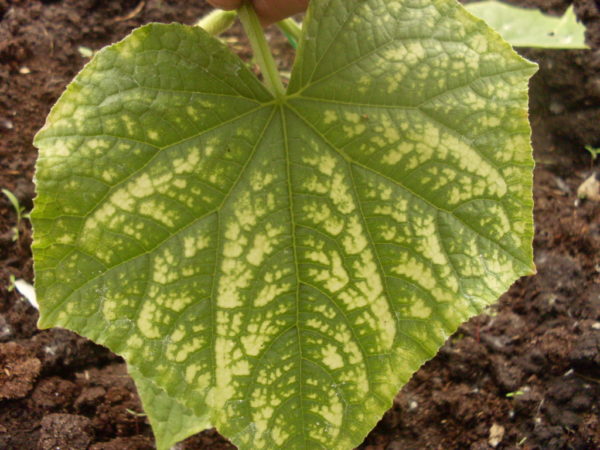
Dark green leaves in cucumbers are considered a sign of health. The appearance of yellowness - an occasion to think about the lack of trace elements in the soil. It is for this reason that the plant decreases the formation of chlorophyll, which is needed for photosynthesis. The plant weakens and focuses all its forces not on fruit formation, but on survival.
It is worth remembering that the excess also negatively affects the level of the future crop. Each of the necessary elements must be present in the soil in a certain amount, since all of them are needed by the plant.
Potassium deficiency
You can determine the lack of potassium in cucumbers by characteristic signs:
- a light border appears on the leaves;
- the plate itself darkens and takes a domed shape;
- fruits are rounded and grow on shortened stalks;
- shoots quickly wither.
To solve the problem, it is necessary to pour cucumbers with a solution of ash. For 10 liters of water take 1 tbsp. About 1 liter is poured under each bush. And the leaves are sprayed with a 0.5% solution of potassium permanganate with soap.
Nitrogen deficiency
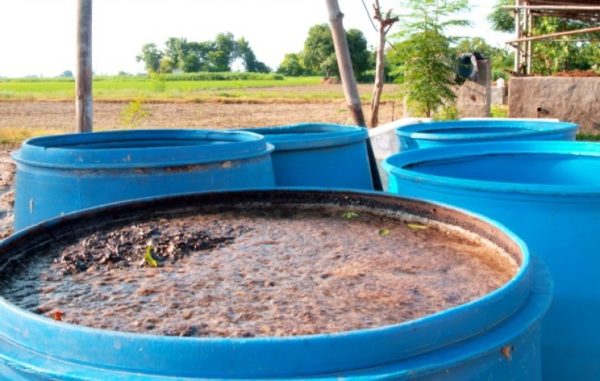
Rarely can you find a lack of this nutrient in cucumbers. But it’s worth knowing about him.
The main signs of nitrogen deficiency:
- plant stems become thinner, become fibrous and hard;
- upper leaves turn yellow-green;
- lower ones completely wilted;
- few fruits appear, they are small in size;
- the very tips of the cucumbers have a thin, pointed shape;
- the general appearance of the plant is painful.
To feed cucumbers in case of a lack of nitrogen, mullein is used. Dilute it with water in a ratio of 1 to 10. The norm of watering is 1 liter of solution per 1 plant.
Magnesium deficiency

Signs of a lack of trace elements in cucumbers appear only on the leaves:
- they resemble burnt ones;
- spots of pale green or yellow appear on the lower sheets;
- Healthy greens are preserved only in the vein area.
To compensate for the lack of magnesium, foliar feeding of this substance with nitrite is carried out. 100 g of magnesium nitrite is diluted in 10 l of water. When watering, Nutrivant Drip can be used. If the culture is grown using a hydroponic system add 30 mg of magnesium per 1 liter of water.
Calcium deficiency
Calcium deficiency is manifested by the following symptoms:
- light stripes appear on the leaves, which thicken with time;
- rot covers the flowers; it can even spread to the root system;
- the leaves take the form of a dome, sometimes they become claw-shaped.
To replenish nutrients in cucumbers, foliar application is used. Spray sheet plates with chelated calcium 3%.
Boron deficiency
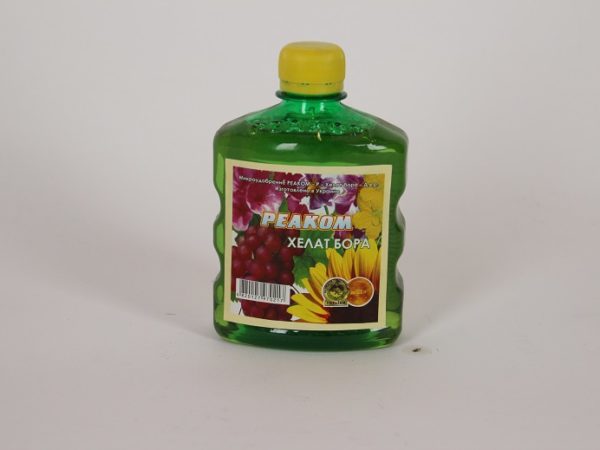
Boron deficiency can be determined by the following signs:
- growth points die off;
- shoots weaken and show a tendency to die off;
- inflorescences quickly fall off without forming ovaries.
Eliminate the deficiency by feeding on a sheet of Chelate Bor. 50 g of fertilizer are diluted in 10 l of water and sprayed with bushes.
Phosphorus deficiency
The micronutrient deficiency is manifested mainly on foliage. Its color becomes grayish, brown spots may appear. Subsequently, the leaves dry out and fall off, wrinkling and bending their edges up.
It is necessary to treat the plant with infusion of superphosphate. It is soluble in hot water. Therefore, 5 tbsp. fertilizers in the evening pour boiling water. And in the morning the mixture is mixed with 10 liters of water. You can also use irrigation bushes phosphatepotash fertilizers.
Molybdenum deficiency
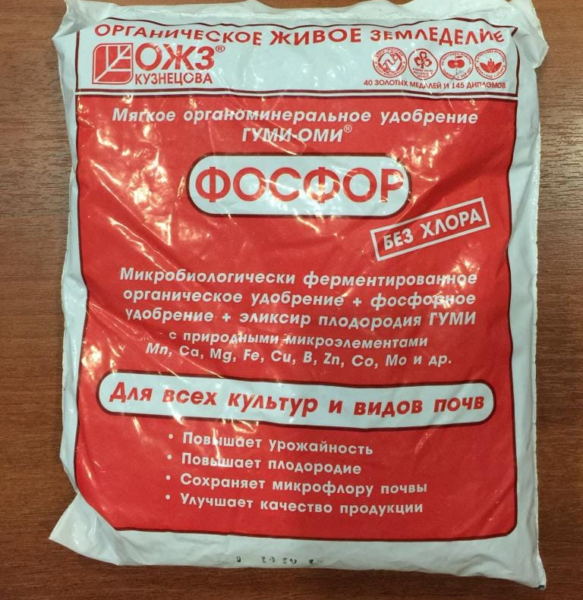
Molybdenum deficiency occurs due to the increased acidity of the soil. The reason may be excessive enthusiasm for sulfate fertilizers or the location of the site in a swampy area. Also, a high content of manganese in the soil can lead to a molybdenum deficiency.
Symptoms of a micronutrient deficiency are manifested by twisting, yellow spots and dry foliage edges. Fruits with molybdenum starvation cannot ripen. They begin to rot while still green. Fertilizers containing phosphorus can help fill the shortage.
Iron deficiency
It is easiest to notice it on young foliage. The very top of the cucumber brightens, small leaves become light yellow and even pale, the plant significantly slows down the growth and formation of flowers.
The lack of iron can be made up by root dressing. A 5% solution of iron sulfate is used for this. Sheet plates can also be sprayed with a solution of ash and soap.
Copper, Zinc and Manganese Deficiency
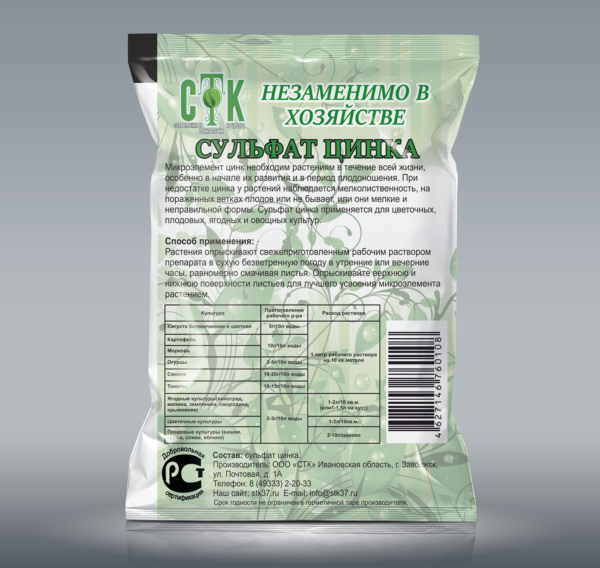
Weak, sluggish shoots on which light leaves are located indicate a lack of copper. Another sign of deficiency is crumbling buds. For prevention, before transplanting seedlings, a 1% solution of copper sulfate is introduced into the soil. You can feed on the sheet. Only the solution must be taken 0.5%.
Zinc deficiency is difficult to determine. Only an experienced gardener with a trained eye can do this. Manifestations of deficiency are the slight yellowing of young leaves and the lack of adult symmetry. In this case, an excess of calcium can cause signs of boric and zinc starvation. You can feed the plant with zinc sulfate. Dilute in 10 l of water 30 mg of fertilizer for cucumbers.
Manganese is directly involved in the absorption of carbon dioxide by cucumber. Symptoms of deficiency are small yellow spots on the upper leaves of the plant. Fruits grow small, slowly growing mass of shoots. You need to feed the plant with a solution of manganese (0.3 mg / liter).
How to determine by leaves what cucumbers lack
Determining the type of deficiency is most easily carried out by photographs of affected leaves. However, common symptoms are so egregious that you can figure out the diagnosis using the usual description. And for reliability, it is better to combine text information with photos.
Table 1 - Signs of micronutrient deficiency.
| Trace element | Sign of deficiency |
| Magnesium | Leaves are covered with colorful spots, showered over time |
| Boron | Leaves in the shape of a spoon. Fruits twist, ovaries and flowers fall |
| Manganese | Chlorosis on young leaves. Over time, they become brownish. |
| Calcium | Light yellow spots on dark green leaves. The back side is purple. The size of the sheets is reduced. The fruits are small and tasteless. |
| Molybdenum | The edges of the sheets are folded into a tube. Veins turn pale |
| Zinc | Young leaves acquire a brown tint that spreads from the legs. Fall over time |
| Iron | Whitish leaves |
| Copper | Blue-green leaves at the edges are wrapped in a straw. The tips begin to whiten near the upper leaves |
With an acute shortage of any of the elements, restoration of the state of the plant will be better managed by root dressing. It will bring effect faster. If the manifestations of the deficit are minimal, then you can use top dressing on the sheet.
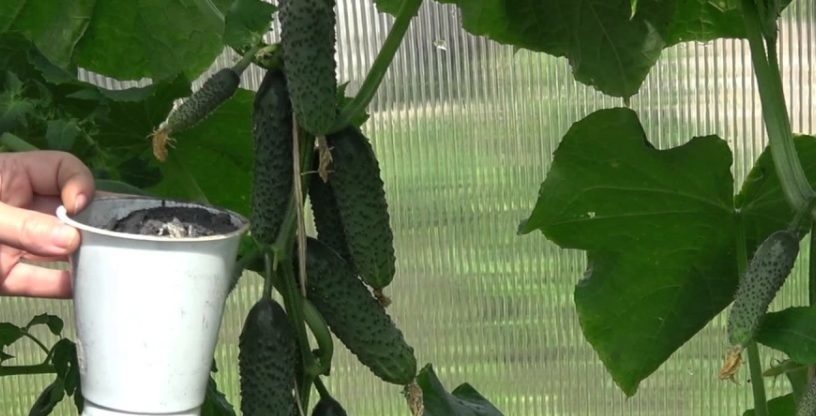 You may be interested in:
You may be interested in:Feeding greenhouse cucumbers
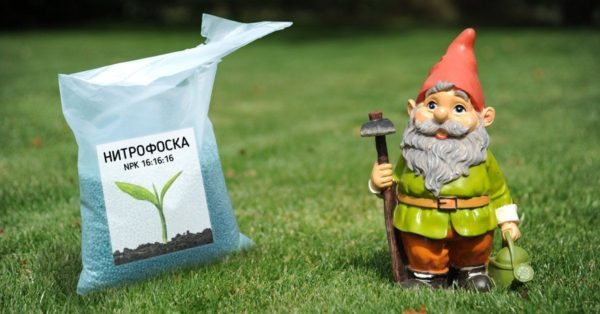
Cucumbers are fed in the greenhouse using organic and mineral fertilizers. Mineral salts are diluted in water before use.
The procedure for feeding:
- Nitrofoska. It contains nitrogen, phosphorus, potassium and calcium. Take 40 g of fertilizer to 10 liters of water. 1 plant in a greenhouse requires 300 to 500 mg.
- Superphosphate. For the best effect, dilute 60 g of superphosphate, 15 g of urea and 0.5 g of boric acid in 10 l of water. It will take 3 liters of solution per 1 sq.m.
- Potassium sulfate. Dissolve 40 g of potassium, 20 g of urea and 0.5 g of boric acid in 10 l of water. For processing you need 3-4 liters per 1 sq.m.
- The same components are used as in the third top dressing with the addition of 40 g of superphosphate. Under each bush, pour 0.5 l of solution.
It is important to carry out the fertilizer in stages, according to the list below. It is then that trace elements will enter the soil in a timely manner.
For adherents of organic fertilizers, there is a technique for feeding with ash. It has a lot of calcium, potassium and magnesium. In 7 liters of water, dilute 1 cup of ash. This volume is enough for 1 sq.m. ridges.
For foliar feeding, the following technology is used:
- 1 glass of ash is boiled for an hour in a liter of water;
- insist 5 hours;
- filter;
- add water to a volume of 4 liters.
- 3.5 liters of cow manure are poured into 6.5 liters of water;
- insist 10 days;
- 1 liter of solution is added to 10 liters of water.
These 10 liters are enough for 1 sq.m. beds. If you feed on the sheet, then the concentration of the solution should be halved.
In a greenhouse, yeast fertilizer can be used. It will make it possible to replenish cucumbers with reserves of potassium, phosphorus and nitrogen. 10 g of dry yeast and 30 g of sugar are dissolved in 10 l of water. Insist 2 hours. Cucumbers are watered with finished slurry 2 times a year, during the formation of flowers and the formation of fruits.
The absence or deficiency of one or another microelement in the soil negatively affects the growth and development of cucumbers. In order to avoid problems during cultivation, it is recommended to timely top-dress with mineral or organic fertilizers. If a deficit has already formed, then descriptions and photos of the affected sheets will help to recognize it. Replenish the stock of the element and restore the plant will help the same fertilizer.




 Armenian cucumber with melon flavor: description and characteristics, reviews
Armenian cucumber with melon flavor: description and characteristics, reviews Do-it-yourself vertical beds for cucumbers: schemes, photos
Do-it-yourself vertical beds for cucumbers: schemes, photos Hollow cucumbers: reasons for the appearance of hollow, what to do
Hollow cucumbers: reasons for the appearance of hollow, what to do Which manure is best for cucumbers: application, how to breed
Which manure is best for cucumbers: application, how to breed